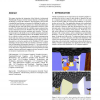Free Online Productivity Tools
i2Speak
i2Symbol
i2OCR
iTex2Img
iWeb2Print
iWeb2Shot
i2Type
iPdf2Split
iPdf2Merge
i2Bopomofo
i2Arabic
i2Style
i2Image
i2PDF
iLatex2Rtf
Sci2ools
SIGGRAPH
1997
ACM
1997
ACM
Interactive simulation of fire in virtual building environments
This paper describes the integration of the Berkeley Architectural Walkthrough Program with the National Institute of Standards and Technology’s CFAST fire simulator. The integrated system creates a simulation based design environment for building fire safety systems; it also allows fire safety engineersto evaluate the performance of building designs, and helps make performance-based fire codes possible. We demonstrate that the visibility preprocessing and spatial decomposition used in the Walkthru also allow optimization of the data transfer between the simulator and visualizer. This optimization improves the ability to use available communication bandwidth to get needed simulation data to the Walkthru in the best order to visualize results in real time; an appropriate communication model and data structures are presented. General issues arising in the integration of environmental simulations and virtual worlds are discussed, as well as the specifics of the Walkthru-CFAST syst...
| Added | 07 Aug 2010 |
| Updated | 07 Aug 2010 |
| Type | Conference |
| Year | 1997 |
| Where | SIGGRAPH |
| Authors | Richard W. Bukowski, Carlo H. Séquin |
Comments (0)

